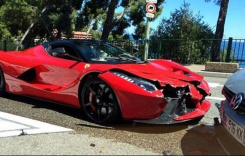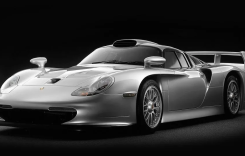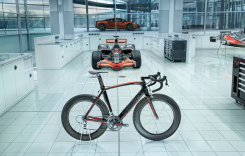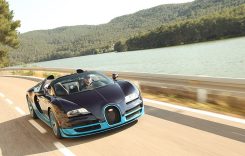Kawasaki has made another major leap in the evolution of 450cc motocross bikes with the new 2015 KX450F. While Kawasaki’s flagship MX platform has, by far, been the most successful bike on the AMA circuit over the last several years in the very capable hands of Ryan Villopoto, factory equipment can be vastly different from stock machinery. However, the gap between works and working class machinery shrinks with each passing year it seems. For 2015, that gap shrank a little bit more with the introduction of the all-new Showa SFF-Air TAC Fork with Triple Air Chamber.
The name might be a mouthful, but that’s because the new Showa fork (the KX450F has come equipped with Kayaba forks since the bike was introduced in 2006) is one of the most advanced suspension components to ever grace a stock MX bike. Yet, the fork is not the only new feature for 2015. Further updates include a new Showa rear shock to match the fork and a 270mm “oversized” front disc made by Braking, as well as a revised Bridge Box piston complimented by new ECU programming. Included with each machine is a digital 300psi shock pump for the fork.

Other minor changes include a lighter rear subframe and lighter front and rear axles. Cosmetically, the KX receives different color styling similar to the Monster Energy Kawasaki factory squad with green anodized engine plugs along with green suspension adjusters and silver matte finished external coatings on the forks.
Broad Braaap
When throwing a leg over the KX450F you immediately notice the comfortable ergonomics and spacious cockpit. The KX is made even more spacious thanks to four-way adjustable handlebar mounts and adjustable footpegs, which can be lowered 5mm. Complimenting all of this are a frame and seat that both allow the rider ample grip on the machine and plenty of space to move around while attacking the track, which is what the Kawasaki does best.
(Above) Overall, the Kawasaki’s KX450F is looking very strong for 2015. (Below) Mid-range power is improved on the 2015 KX450F thanks to a new Bridge Box piston.
Rolling on the throttle at Milestone MX, the KX meets the rider with the forceful grunt of power that has come to characterize the bike since the introduction of EFI. However, now that engine package is not only more easily managed by the rider, it is also customizable both with the DFI Coupler system and the fully programmable ECU (possible with the optional Kawasaki Racing Software Kit). Gone are the days of overwhelming snap on 450cc engines. Now the game is focused on trying to make the power work for the pilot and this is where the 2015 KX450F excels.
The motor starts with a strong low-end that is perfect in deep, sharp, rutted corners and seat-bounce jumps. The power then builds into a beefy mid-range hit that is improved for 2015 with the new Bridge Box piston. For the majority of riders, the mid-range RPMs are the most essential and that is exactly where the Kawasaki shines. From second to fourth gear, there is enough grunt to take on just about any obstacle on a medium-sized track. At a facility such as Milestone MX, a rider can be plenty aggressive while riding in third gear 90% of the time.
As the track dried out, I was more comfortable moving to the Soft coupler, as it allowed me to remain aggressive on the track while more easily maintaining traction on the harder packed conditions. Having only one day of riding on one track does not really offer the opportunity to test out all aspects of a motorcycle. In this case, the tighter Milestone circuit does not truly allow a rider to test out the upper reaches of the top-end powerband. However during the few times that the RPMs began to climb towards their max, I did get the sense that there was plenty of power on tap. For anyone who has ridden a 2013 or 2014 KX450F, you can expect a similar hit up top.

Handling
If there is one undeniable characteristic of the KX450F, it is the overall stability of the chassis. Kawasaki’s current generation frame has become known for its predictability and neutral feel. The green beast will not turn on a dime, but it also will not understeer and try to climb out of a rut. Since the majority of turns on any given track will be somewhere in between sharp and sweeping, this means that the Kawasaki should, in theory, feel at home the majority of the time and that is exactly the case. In fact, just about the only place that the KX450F does not excel in terms of handling is in extremely tight turns. Everywhere else, you will rarely find yourself more comfortable on a motocross bike. Sweeping flat turns, wide rutted bowls, 180 degree berms; take your pick, the result will still be a stable and predictable ride.
In order to hit those turns properly, a bike needs good brakes. With the KX’s new oversized front rotor, braking is not a problem. Both the 270mm front and 240mm rear discs now have a more aggressive wave design that both increases friction and cooling. Since many consumers were switching to oversized aftermarket discs anyways, Kawasaki figured they could take yet another puzzle out of the equation for new owners.
In the air the Kawasaki is balanced, and while it feels a bit on the heavy side at times, this is partially due to the larger layout of the frame and ergonomics. Even so, there is still plenty of the maneuverability once airborne. But what goes up, must come down, which brings us back to the biggest change for 2015: the suspension.

Green Suspenders
Showa’s all-new SFF-Air TAC Fork with Triple Air Chamber may look familiar to moto nerds. And that’s because the SFF-Air TAC is a derivative of the forks that several factory riders, including Ryan Villopoto, began racing with in 2013. Not often does works technology trickle down so undiluted to the consumer, but for those in the market for a new bike in 2015, this is one of those rare instances.
Kawasaki introduces the all-new Showa SFF-Air TAC Fork
with Triple Air Chamber on the 2015 KX450F.
So how does this new fork operate? The Separate Function Fork means that the left side handles all of the valving, compression, and rebound damping while the right side with the air serves as the sprung or resistance fork leg, although there is no actual spring. Three different air chambers keep the right leg in balance.
The main upper chamber handles the majority of the work, with a stock 145psi setting while a narrower outer chamber rests much lower at 7.25psi. These are both kept in “harmony” by the lower balance chamber (integrated into the fork lug), which is set at 130psi. The SFF-Air TAC offers an unprecedented amount of adjustability for stock front suspension.
With all of the attention up front, it is easy to miss the fact that the rear shock is also a new Showa unit (again, a change from the KYB shocks that have been used since 2006) with revised valving, a Kashima coated inner body, and an optional longer tie rod that lowers the seat height by 4mm.
On the track, the difference in feel from a regular spring fork to the Showa SFF-Air TAC is immediately noticeable. While our test track for the day developed few bumps, the chop that did exist was almost a non-issue with the new fork. Where one might expect a small twitch or quick hit to the wrists, the fork took nearly all of the impact. Through larger, straight-on bumps and whoops, the SFF-Air TAC handled as though it had been customized to my preferences, as was also the case on jump faces and landings. Perhaps the most impressive aspect right off the bat was the fork’s bottoming resistance on flat landings or when over jumping. All of this action is balanced very well by the Uni-Trak Showa shock out back.
However, nothing is perfect. The two areas with the fork that gave me issues initially were straightaways and the transitions for turns. On straights there was a slight feeling of the forks squatting as though they were sitting a little too low in the stroke while under acceleration. When setting up for turns, specifically in the transition from standing to sitting while in a turn, the front end would develop a vague feel caused by a tendency for the fork to blow through the initial few inches of travel.

Both of these issues were addressed back in the pits by Kawasaki technician, Brett Leif, who went three clicks further in on the compression adjuster, but left the air fork alone. This simple and quick change made a world of difference on the track. Gone was the vague feel in the turns and squatting on straights, replaced by a much more positive, firmly planted sensation at the front wheel.
Overall, the Kawasaki’s KX450F is looking very strong for 2015. While the aesthetics have not changed much for this model year, this in no way hinders the performance. If you were a fan of the KX450F, you can only expect improvements on what was already a very strong package.









